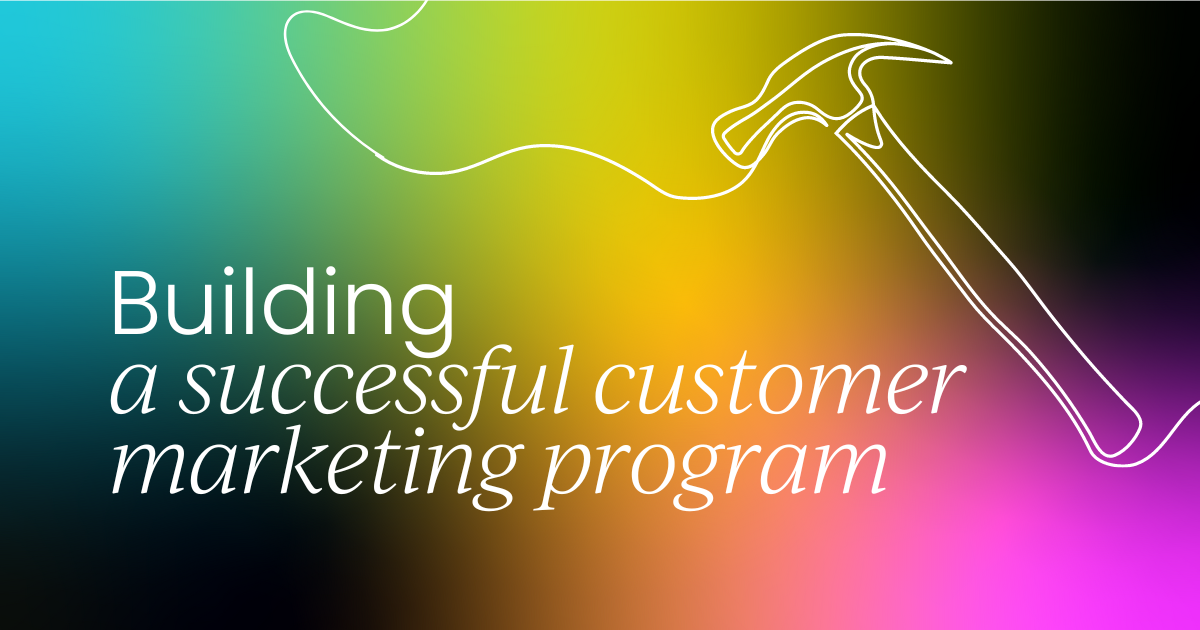A winning product isn't enough. To truly thrive, businesses need to cultivate strong, lasting relationships with both their customers and their partners.
At the heart of this crucial strategy lies professional roles like that of the Product Marketing Manager (PMM), a strategic leader who expertly orchestrates a complex interplay of communication, collaboration, and data-driven decision-making.
This isn't simply about creating marketing materials; it's about building a holistic ecosystem of engagement and advocacy that fuels sustainable growth.
This in-depth exploration will uncover the essential role of these leaders, highlighting their responsibilities, navigating common challenges, and demonstrating how they measure their impactful contributions.
Understanding customer and partner marketing
While building and nurturing strong relationships is paramount for sustained growth, this requires a sophisticated approach to both customer and partner engagement.
Let's clarify the distinct yet interconnected roles of customer and partner marketing.
Customer marketing focuses on building and nurturing relationships directly with your end-users.
This involves creating compelling content and campaigns tailored to their specific needs and preferences. The goal is to foster engagement, drive loyalty, and encourage advocacy throughout the customer journey, leading to increased retention and positive word-of-mouth referrals.
Effective customer marketing translates into a strong and loyal customer base, which becomes a valuable asset for future growth.
Partner marketing, on the other hand, leverages the power of strategic alliances to amplify your reach and enhance your brand's credibility. This involves collaborating with other businesses to co-create value and tap into new markets.
Joint initiatives, such as co-branded materials, shared campaigns, and joint events, create synergistic opportunities that benefit both partners. The result is expanded market penetration, enhanced brand recognition, and the ability to reach new customer segments through trusted and established channels.
Strong partnerships not only amplify your marketing message but also build credibility and trust among your target audience, further bolstering your customer marketing efforts. In essence, customer and partner marketing work in tandem, creating a powerful and holistic growth strategy.

Aligning customer and partner engagement
Marketing leaders like the PMM often take on far more than the traditional idea of 'a marketer'; they are the strategic conductor of a complex orchestra, harmonizing customer and partner engagement to drive sustainable business growth.
Their role transcends individual marketing tasks; they are the architects of a holistic ecosystem where every interaction, from content creation to partner collaboration, contributes to a unified and impactful brand narrative.
This orchestrated approach ensures that customer and partner strategies aren't disparate efforts but rather integrated components of a larger, cohesive growth strategy. Let's examine how these leaders achieve this…
Aligning goals
Rather than operating in silos, the marketer works collaboratively with leadership to establish overarching marketing objectives that encompass both customer and partner strategies.
This involves thorough market research to understand market trends, competitive landscapes, and the unique needs of both customer segments and potential partner organizations.
Detailed profiles of ideal customers and partners are created to guide targeted messaging and efficient resource allocation. Crucially, they ensures that customer and partner marketing initiatives work in harmony to achieve shared business objectives, such as increased market share, enhanced brand awareness, or revenue growth.

Fostering cross-functional collaboration
The PMM acts as the central hub, fostering seamless collaboration between various departments. They work closely with the sales team, ensuring they are equipped with the necessary resources—battle cards, presentations, and compelling value propositions—to effectively communicate with customers and partners alike.
Customer success data is leveraged to inform marketing strategies and enhance the overall customer experience. This includes utilizing customer feedback, success stories, and testimonials to build credibility and trust.
Close collaboration with product management ensures marketing campaigns accurately reflect product capabilities and address customer needs.
Finally, the PMM develops and executes joint marketing initiatives with partners, creating co-branded materials, shared campaigns, and collaborative events. This requires exceptional communication and negotiation skills to forge mutually beneficial agreements.
Crafting effective content
Professionals in positions like that of the PMM lead the creation of compelling content that resonates deeply with both customer and partner audiences.
Engaging content, such as case studies, blog posts, and videos, is developed to highlight the value proposition for customers, fostering brand loyalty and advocacy.
Simultaneously, the marketer creates co-branded materials, joint press releases, and shared content to leverage the strengths of strategic alliances. This requires maintaining a consistent brand voice and message across all customer and partner touchpoints, creating a cohesive and impactful brand experience.
Creating a feedback loop
These marketers establish and manage a continuous feedback loop to inform and improve both customer and partner marketing strategies.
This involves analyzing data from various sources—surveys, reviews, customer support interactions, and partner performance metrics—to gain valuable insights into customer needs and preferences, as well as the effectiveness of partner collaborations.
This data is then used to refine marketing strategies, allocate resources efficiently, and maximize return on investment (ROI).
Strategic events and relationship building
PMMs and other marketing leaders play a vital role in planning and executing events designed to foster strong customer and partner relationships. They organize webinars, workshops, or conferences to build customer loyalty and provide valuable insights.
Simultaneously, they participate in industry trade shows and organize joint events with partners to showcase mutual benefits and expand network reach. This event strategy strengthens existing relationships and cultivates new opportunities for growth.
Challenges faced by marketers and strategies for success
Having said so much about how marketers bridge between customer and partner marketing, the path to success is rarely smooth. As an example, PMMs consistently encounter obstacles that demand creative problem-solving and strategic thinking.
Understanding these challenges and proactively addressing them is crucial:
- Communication silos: Fragmented communication across departments can lead to misaligned messaging and missed opportunities. Solution: Implement regular cross-functional meetings, utilize shared platforms for collaboration, and champion open communication.
- Feedback gaps: Without structured mechanisms, valuable customer and partner insights are lost. Solution: Establish systematic feedback loops through surveys, interviews, focus groups, and regular review meetings.
- Underleveraged customer stories: Missed opportunities to showcase the value proposition and build credibility. Solution: Develop a content calendar that consistently highlights customer success stories across various channels.
- Inconsistent branding and messaging: Diluted brand narrative confuses audiences and weakens impact. Solution: Develop and maintain a comprehensive brand style guide, ensuring consistency across all communication channels.
- Resource constraints: Limited budgets and competing priorities require efficient resource allocation. Solution: Prioritize high-impact initiatives, leverage automation tools, and track ROI meticulously.
- Building Bridges: Essential Stakeholders for success
One essential path to the seamless execution of customer and partner marketing is by cultivating strong relationships and facilitating collaboration with key stakeholders.
Based on their influence and importance in shaping and contributing to the overall product marketing initiatives, the stakeholders are categorized as primary and secondary.
Primary Stakeholders: This category includes, Customer Success Managers (CSMs), Partner/Alliance Managers, Product Management, and Executive Leadership Team (ELT).
- Customer Success Managers (CSMs): They help gather insights from customer interactions, capture success stories, and ensure feedback is integrated into marketing.
- Partner or Alliance Managers: They coordinate partner marketing efforts and develop value proposition content that aligns with the joint goals.
- Product Management: They ensure the customers and partners are timely informed about the product features and updates for accurate positioning.
- Executive Leadership Team (ELT): Their involvement is crucial for strategic alignment and resource allocation to support broader business goals.
Secondary Stakeholders: This category includes, the Marketing and Communications Team, and Sales Teams.
- Marketing and Communications Team: They help maintain consistent brand messaging and execute PR, website updates, and case studies.
- Sales Team: Their alignment ensures that the right resources are produced to effectively engage with customers and prospects.
- Measuring success
Demonstrating the value of a PMM’s, or marketers, contributions requires a results-oriented approach to measurement.
Rather than relying on superficial metrics, a marketers success is best reflected in tangible business outcomes.
Key performance indicators (KPIs) are crucial for showcasing the impact of their efforts in customer and partner engagement, aligning directly with overall business objectives. These KPIs demonstrate the effectiveness of initiatives across various aspects of marketing, providing a clear picture of the contribution to growth and success.
Some metrics to keep track of include:
- Website Traffic and Engagement: The ability to create engaging content is reflected in increased website traffic and user engagement. Compelling case studies and other high-quality content attracts visitors, improving customer retention and driving conversions.
- Lead Generation from Joint Campaigns: Successful collaboration with partners results in a significant increase in qualified leads. Joint marketing initiatives create valuable opportunities for the sales team, expanding market reach and generating strong sales pipelines.
- Enhanced Customer Engagement: The focus on building relationships is demonstrated by increased customer engagement across various channels. Successful customer advocacy programs and targeted content campaigns foster deeper connections with customers, encouraging loyalty and advocacy.
- Event Success and Follow-up: Well-executed events build brand awareness and generate leads. A PMM's ability to organize and manage events, followed by effective post-event communication, is reflected in strong attendance rates and increased engagement from attendees.
- Sales Enablement and Cycle Optimization: Improved sales performance showcases the effectiveness of sales enablement efforts. Providing sales teams with targeted materials and training leads to shorter sales cycles, higher conversion rates, and increased revenue generation.

Final thoughts
As businesses navigate increasingly complex markets, the need for a strategic approach to customer and partner marketing becomes even more critical.
The marketer, armed with data-driven insights and a commitment to collaboration, is essential for driving future growth.
By building strong relationships, optimizing marketing efforts, and continually adapting to changing market dynamics, professionals like the PMM positions organizations for sustained success in the years to come.







